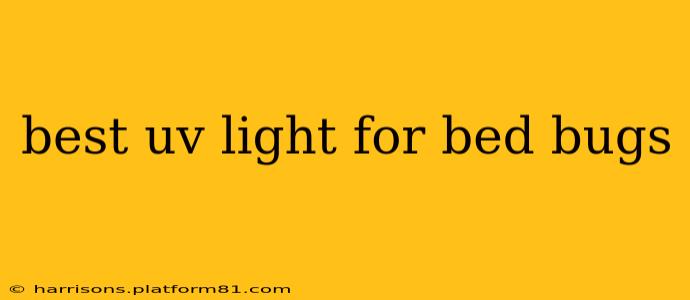Finding the best UV light for bed bug detection can feel overwhelming. The market offers a wide array of options, each promising effective pest detection. However, understanding the nuances of UV light technology and its application in bed bug detection is crucial for making an informed decision. This guide will help you navigate the options and choose the most suitable UV light for your needs.
What is a UV Light and How Does it Work for Bed Bug Detection?
UV lights, or ultraviolet lights, emit light beyond the visible spectrum, in wavelengths shorter than visible violet light. While UV light itself doesn't kill bed bugs, it can help in their detection. Bed bugs, particularly their excrement, sometimes fluoresce under UV light, appearing as bright spots or trails. This fluorescence is not always guaranteed, as it depends on several factors, including the age of the excrement and the type of surface. Therefore, a UV light should be considered a supplemental tool, not a standalone solution.
Do UV Lights Kill Bed Bugs?
No. UV lights do not kill bed bugs directly. While high-intensity UV radiation can be lethal to some organisms, the UV lights typically used for bed bug detection are not powerful enough to achieve this. Their primary function is to aid in the detection of bed bugs and their feces, allowing for targeted treatment.
What are the Different Types of UV Lights for Bed Bug Detection?
Several types of UV lights are available, each with its advantages and disadvantages. The key differences lie in their intensity, portability, and features. Some common types include:
- Handheld UV Lights: These are compact and portable, ideal for quick inspections of smaller areas. They're often battery-powered, making them convenient for use in various locations.
- Larger, More Powerful UV Lights: These are typically used for larger-scale inspections or professional pest control services. They often have adjustable intensity and may include additional features.
Remember, the effectiveness of any UV light depends on several factors including the age of the bed bug infestation, the cleanliness of the surface, and the sensitivity of the user's eyes. Sometimes, the fluorescence is subtle and requires a trained eye to detect.
What are the Best Features to Look for in a UV Light for Bed Bugs?
When choosing a UV light, consider these key features:
- Wavelength: Look for a UV light with a wavelength around 365nm, which is generally effective for bed bug detection.
- Intensity: Higher intensity lights often provide better visibility of fluorescent stains. However, extremely high intensity might also be blinding.
- Portability: A lightweight, battery-powered handheld device is often the most practical choice for home use.
- Durability: Choose a UV light made from high-quality materials that can withstand regular use.
How Effective Are UV Lights in Finding Bed Bugs?
UV lights are a helpful tool in bed bug detection, but they are not foolproof. Their effectiveness depends on several factors, including the age of the infestation, the surface material, and the observer's experience. A negative result from a UV light inspection doesn't necessarily mean a complete absence of bed bugs.
Are There Any Alternatives to Using a UV Light for Bed Bug Detection?
Yes, there are several other methods for detecting bed bugs, including:
- Visual Inspection: Thoroughly examining bedding, mattresses, furniture, and walls for signs of bed bugs (adults, nymphs, eggs, or fecal spots). This often requires a magnifying glass and a keen eye.
- Interception Traps: These traps are placed under the legs of beds and furniture to catch bed bugs as they move.
- Professional Pest Control Inspection: Hiring a professional pest control service provides the most comprehensive and reliable detection method.
Choosing the right UV light for bed bug detection requires careful consideration of your specific needs and the limitations of this detection method. Always remember that UV light is just one tool in a broader approach to bed bug control. A comprehensive strategy that may involve multiple methods often yields the best results.
